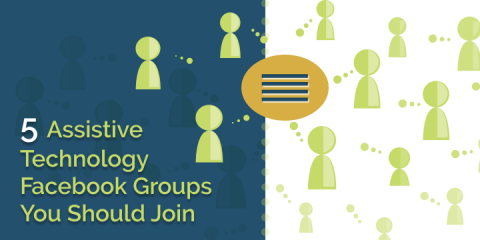
5 Assistive Technology Facebook Groups You Should Join

Article republished with permission from Tecla
One of the greatest features on Facebook that allows like-minded people to connect outside of their inner circle is groups. A Facebook group is a page that can be created for an organization or business to promote activities or for a specific topic that enthusiasts can learn more about and contribute to the conversation. Every day, people around the world use Facebook groups to connect with people in their field, who use the same technology or are eager to learn, share information, and express themselves.
Users can join the group and post their thoughts on a wall and interact through discussion threads. For people who use assistive technology or support users by making, setting up, training, or recommending different solutions, there are several Facebook groups with thousands of members to connect with. Here are our 5 favourite groups that discuss topics and ask questions related to assistive technology.
1. Assistive Technology
Member Count: 5,051 (as of 4/9/19)
Assistive Technology is a Facebook group that has a focus on all things related to assistive technology, meaning, discussions on any aspect of AT including wheelchairs, AAC, speech-to-text, etc. are encouraged. This group has a broad focus, so it’s perfect for new members that support individuals who use a variety of assistive devices and software. If you’re a clinician starting out with a new tool or want to know how to use it to its full potential, this is a great space to learn from advanced users and gain more expertise in the assistive technology field. From low-tech to high-tech devices, and the accessories that support them, you are guaranteed to find an expert that can answer your question related to AT for vision, hearing, physical and motor skills, and cognitive impairments in this group.
2. Tecla Community
Member Count: 280 (as of 4/9/19)
The Tecla Community is a space for people living with paralysis, Occupational Therapists, Assistive Technology Specialists, Speech-Language Pathologists and anyone who is familiar with or new to switch access for mobile technology. Before we created this group, we were working through cases individually with our users and realized that so many others could benefit from joining and observing these conversations. It began as a Facebook group where users could ask each other questions and help each other through different situations with their smart devices and evolved into a community where anyone who wants to learn more about tecla-e can join the discussion. This group is ideal for new members who want to learn more about transitioning from traditional assistive devices to mobile access tools, as well as experienced Tecla users that have been using the devices for access since the first one was released 6 years ago. Connecting with other users has the potential to give new Tecla fans and customers peace of mind knowing they will have 24/7 access to support from their peers.
3. HandsOptional
Member Count: 428 (as of 4/9/19)
HandsOptional is another group focused on switch access for people with paralysis, but with a focus on iOS, macOS, and tvOS devices using Apple’s Switch Control accessibility feature. Like the Tecla Community, members ask each other questions when they’re stumped and chat about the latest iOS updates and devices.
Here’s an example of a question posted by a HandsOptional member:
This question shows the value in joining Facebook groups related to assistive technology when you have a topic that is extremely specific. You may not know all the answers to the posts in these groups, but you can learn new tricks by observing the discussions of other members!
4. AAC Through Motivate, Model, Move Out Of The Way
Member Count: 7,755 (as of 4/9/19)
This group was created to connect those who work with clients who are nonverbal or not easily understood and require either supplementary or alternative methods for oral communication. AAC (alternative augmentative communication) covers communication devices, software, strategies and tools (eg. paper-based methods) that add to or replace natural speech. Tecla users primarily use AAC apps like Proloquo2go, which they can access through ability switches. The majority of members are special education teachers, speech-language pathologists, and parents of AAC users, so you’ll find most discussions are sharing stories of users and successful activities that resulted in a progression in communication skills. P.S. October is AAC awareness month!
5. ATMakers – Makers & Users
Member Count: 2,258 (as of 4/9/19)
A community for innovators, ATMakers brings together assistive technology software and hardware manufacturers, inventors and DIY lovers, and users that are interested in development and giving feedback. You’ll also find programs such as university-based assistive technology projects and robotics competitions whose main goal is to develop new and innovative solutions for people with disabilities. Observing discussions in this group is a great way to learn more about trends in the industry, upcoming events, methods for developing accessibility apps, adapting toys, and more. The Tecla team had joined all of these groups, so you’ll be sure to connect with and learn from a Tecla expert, whether they are a user or team member.
• • •
Along with 23 other supportive solutions, the tecla-e, a cloud-connected assistive device, was featured in the TRCs 24 Days of Technology 2018. For more information on Tecla by Komodo OpenLab, visit https://gettecla.com/.
Don’t miss the next article!
Visit the ARRM Technology Resource Center to learn about more success stories and case studies showing how technology is changing the lives of those living with disabilities or learn more about how to start the conversation.




